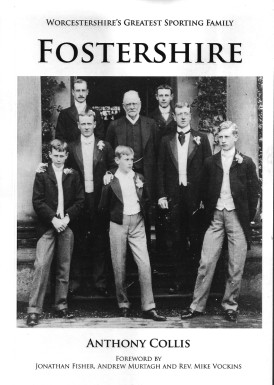Fostershire
Martin Chandler |Published: 2018
Pages: 243
Author: Collis, Anthony
Publisher: Collis, Anthony
Rating: 4 stars

The largely forgotten name of Tip Foster got a few mentions on 28th December 2017, and the following night all England hoped he would finally lose the record he had set more than a century ago. Alas it was not to be. Jimmy Anderson succumbed to the first ball of the day, leaving Alistair Cook high and dry on 244, still 43 runs short of Tip’s record score for England in Australia. One day that record will be broken, but Tip has another claim to fame that most certainly won’t be emulated. In 1907 he skippered England’s cricketers against South Africa, five years after he had led his country in a full soccer international against Wales.
It seems odd that such a man has not been the subject of a biography before, but perhaps there just wasn’t the material. After all there were no three figure scores other than that unbeaten 287 in Tip’s eight Tests, and only a couple of goals in his handful of soccer internationals. There were no great controversies, and the successful career on the stock exchange that restricted his availability for his sport is not particularly exciting. In addition death from diabetes at the tragically early age of 36 brought the story of Tip Foster to a premature end.
So how does Anthony Collis find enough material for 243 pages? To start with only the first 103 narrate Tip’s life, and that is punctuated by, just to put things in context, a few paragraphs of social and sporting history as Collis starts each new year. A few have done this recently, and I am sure many more will in years to come. It is a feature that works very well.
Fostershire can however be a little disjointed at times. There are some lengthy quotes, at one point a whole article from Cricket: A Weekly Record of the Game. The chapter on the 1903/04 series is essentially the contents of a diary kept by Tip supplemented by observations from the account of the tour written by skipper ‘Plum’ Warner. In addition the narrative is punctuated from to time with short digressions on some of the other characters who crop up in Tip’s story.
Are these criticisms? The final one certainly isn’t, as these brief pen portraits work very well. As far as the quotes and the diary are concerned they might have been better used with some judicious editing and/or being woven into Collis’ own narrative, but that is a minor quibble and, with some justification, Collis’ response might well be that he was simply trying to give his reader a flavour of the times he was writing about.
The second part of the book leaves Tip behind and is, in this reviewer’s opinion, even more enjoyable than Tip’s own story. The clue is in the book’s title of course, as whilst none of them were in the same league as Tip as a cricketer he did have as many as six brothers who also played First Class cricket for Worcestershire. Each of them has their story told; Harry, Land Agent, Worcestershire skipper and England selector; Wilfred the career soldier; Basil the actor; Geoffrey, secretary to Ranji and the younger two, Maurice and Johnnie, of whom the best single word description is probably entrepreneur, the more so in Maurice’s case. All led interesting lives in their own right.
In addition to the brothers Collis also takes time to look at the lives of the Foster parents, as well as the four sisters. Tragically the eldest died before reaching her second birthday, but the three who survived all led interesting lives and the youngest, Cicely, was a very talented sportswoman.
The immediate family dealt with there are then as many as six appendices. The first looks at the interesting question of the family’s descendants, a number of whom assisted Collis in his research. There were a few decent sportsmen amongst the not inconsiderable number of people identified, but perhaps surprisingly no outstanding ones.
There follows a history of one of the family names, Knollys, extracts from some letters written by Wilfred to his mother from the time of the Boer War, some details of Geoffrey’s military records, a couple of pages on three bats held at Old Swinford Hospital (despite what the name suggests it is a school) and, finally, what amounts to a list of some of the plays in which Basil appeared between 1906 and 1938.
Fostershire is an excellent read. Had the book been anything other than self-published I would have had a grumble about the way it has been designed and laid out, but the rules of engagement are very different for authors who are neither professional writers nor publishers. Anthony Collis deserves to have his book judged purely on its content, and on that basis it is recommended reading for anyone interested in cricket’s ‘Golden Age’. Also worthy of mention are a very good selection of photographs, a decent index and whilst a few more statistics would have been welcome, the basic records of the brothers’ careers are all included.
Interested purchasers can contact the author directly at adcollis@blueyonder.co.uk






Leave a comment